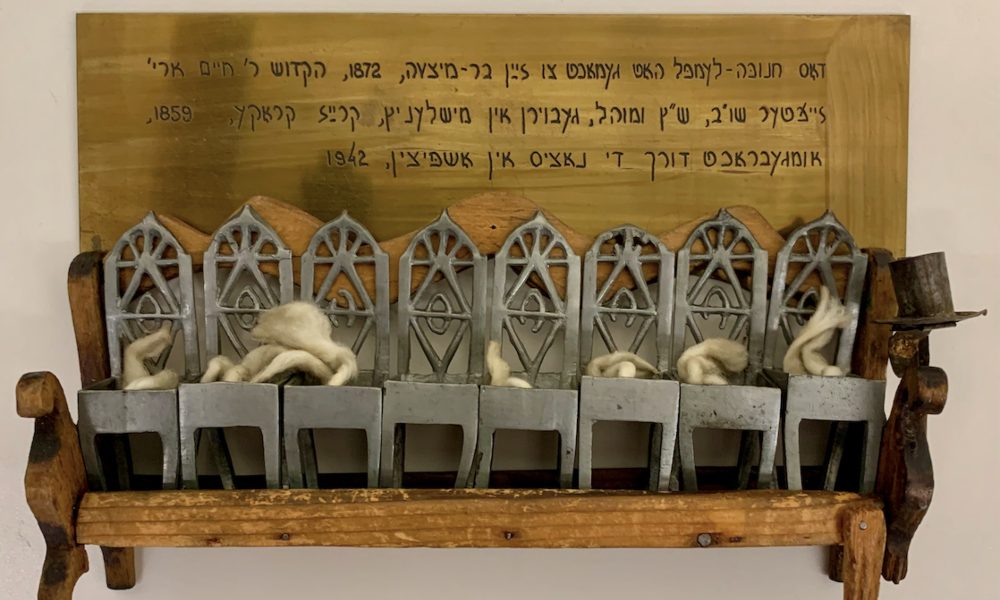“What was Hanukkah like when you were a child?” I asked my New Haven neighbor, who was a survivor of the Holocaust in Poland as well as a careful carrier of memories. This is how she answered: “I remember our parents gave us sweets, apples or nuts and small things that were useful, mittens or pencils. I remember the lights…”
The YIVO Institute in New York has an object in its collection, the Seifter Menorah, that might have been familiar to my neighbor from her pre-war childhood. Also from Poland, the menorah consists of eight cast-pewter or cast-lead, chair-shaped Hanukkah lamps, each one about a finger’s length in height. As a group, the miniature straight-back chairs form a kind of diorama. Lined up in a row and set on a little pedestal-like wooden bench, they are reminiscent of the seats in a synagogue. The chairs can be removed to stand individually in order to be cleaned or played with after the holiday. A tiny lamp-shaped vessel is attached to one side of the handmade bench and that is where a single candle might be placed as the shamus. The seat of each tiny chair is constructed so that oil can be poured inside a small well, which is fitted with a wick.
Historians tell us that menorahs and dreidels like this were part of a folk tradition. They were often used by children in Eastern Europe or Germany, and the children sometimes crafted the molds themselves. This one was the work of Chayim Areh Seifter, who was born in 1859 in Myślenice, near Kraków. He made it in 1872 when he was 13, and years later he gave it to his son Jacob when Jacob left for America in 1905—a token from the past that carried a father’s fingerprints from a vanishing world. In 1942, in America, Jacob Seifter received the tragic news from neighbors in Myślenice that his father had been killed in Auschwitz.
At just about the same time, the YIVO Institute in New York, responding to the dire reports coming from Europe, began planning a museum that would house artifacts, documents, photographs and clothing, remnants of the life of Eastern European Jewry as it had existed before the catastrophe. At first the proposed project was called the Museum of the Jewish Town and, later, the Museum of the Homes of the Past. YIVO sent out pamphlets asking for donations, stressing how important it was to have a historical record of the once-thriving Jewish regional life that existed before World War II. Although the physical museum was never built, between 1943 and 1945, YIVO collected hundreds of objects that are now part of its archive and can be viewed on tours given by the curators and seen through its digital databases. As a collection, they help to provide an account of a destroyed world. They are witnesses.
Jacob Seifter received a YIVO pamphlet at his home in Cleveland and was moved to donate his father’s menorah, explaining his painful decision in a letter penned in beautiful Yiddish handwriting and recently translated by his great-grandson Rabbi Daniel Z. Stein, who has also written about the family heirloom: “So that, God forbid, it should not be lost, I give this menorah to the YIVO in New York as a gift. My heart breaks that I am compelled to give away such a family treasure, and with difficulty, I say, it is so hard for me to part with you.” He then added his own contribution to his father’s menorah, attaching a small memorial plaque to the back of the little bench supporting the eight chair-shaped lamps. He inscribed the plaque, using engraving skills he had learned when he had worked in the New Cemetery in Kraków before emigrating to America. It reads: “This Hanukkah lamp was made by the martyr R’ Chaim Aryeh Seifter, khazn, shoykhet, and moyel, for his bar mitzvah in 1872. Born in Myślenice, near Kraków, in 1859, he was murdered by the Nazis at Oshpitzin in 1942.”
As is often the case with material culture, the Seifter menorah tells a complex story. Crafted by a father and added onto by a son, it is an accidental survivor of an almost-annihilated culture, embodying the intimacy of a family heirloom, the usefulness of a ritual object, the historical significance of a work of folk art, the grief of an object of mourning, and the magnitude of a memorial object.

